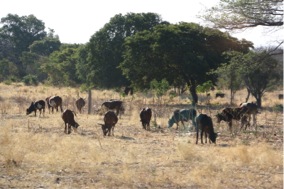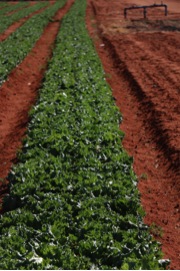In Namibia there are two types of farming: commercial and communal. As pictured below, commercial farming is for profit and is most commonly found in southern Namibia. Commercial farming is also commonly found in the United States. Communal farming uses one piece of land and its resources to farm (Kalundu). Communal farming includes grazing, harvesting plants, and raising livestock. Communal farming began before Namibian independence in 1994 and continues today in the northern parts of Namibia (Mendelsohn).
Along with the majority of the Namibian population, the majority of the cattle of Namibia are located in the northern, communal regions (pictured below). Unfortunately, the Namibian government has declared a “Red Line,” separating the north and south parts of the country (Schneider). This line has been set to prevent the spread of disease between the two halves. The northern region tends to have less animal health care leading to the spread of disease. Meat products can only be exported from the south to the north, but not vice versa.

Pictured here are cattle in the northern region. Cattle graze wherever they please and come back home at the end of the day. Individual farmers must know what their cattle look like.
Namibia has the potential to become a powerful producer of meat products due to the high volume of cattle, goats, and sheep that are located in the northern region (Mendelsohn). The only obstacle is ridding Namibia of the “Red Line.” To do this, Namibia must first increase the availability of animal health care and then improve the knowledge of animal health care in the northern region.
Next, a controversial topic in Namibia: the commercial farm movement. I believe there should be an increase in commercial farms. Commercial farms have been proven to be more efficient and productive. The United States began farming in communities and struggled until it converted to commercialism. The techniques, knowledge, and technology of commercial farming are reasons for its success. Currently, 50% of the Namibian population depends on subsistence agriculture for their livelihood (Schneider). Converting to commercial farming would create enough produce and animal products to feed families, sell at market, and employ much of the unemployed population.
I believe that Namibia has great economic potential lying in the northern region. The government must take action to unlock its potential. Education of animal husbandry and health care should be encouraged in schools. Technology must be incorporated into new farming techniques. The big question: Where will the money come from to fund these projects?
